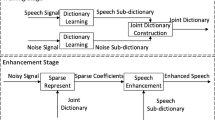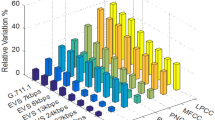Abstract
Speech compression or speech coding is inevitable for effective communication of speech signals in resource limited scenarios and researcher’s have been working on achieving lower and lower transmission bit rates (BR) without much compromise on the quality of speech. Medium BR hybrid speech coding schemes have gained much interest in the recent years with most of them based on CELP, the basic medium bit-rate coding scheme. In this work, we provide an insight to the capabilities of compressive sensing (CS) in speech processing and propose a novel idea in the quantized framework. Three major aspects demonstrated in this paper are (1) Inherent de-noising of noisy speech by the CS based coder along with compression (2) Quantization of CS measurements to achieve medium transmission bit-rates and (3) Enhancement of quality and compression performance of the coder with better sparse representations of speech using dictionaries. The results indicate that the proposed scheme offers better compression in comparison with basic Gaussian codebook CELP. The CS scheme has the added advantage of inherent noise suppression and provides more robustness to background noise in comparison with parameter extraction based medium bit-rate speech coding systems.








Similar content being viewed by others
Explore related subjects
Discover the latest articles, news and stories from top researchers in related subjects.Notes
References
Aharon, M., Elad, M., & Bruckstein, A. (2006). K-SVD: An algorithm for designing overcomplete dictionaries for sparse representation. IEEE Transactions on Signal Processing, 54, 4311–4322.
Andreas, S. (1994). Spanias, speech coding: A tutorial review, Proceedings of the IEEE, vol. 82(10).
Chu, W. C. (2003). Speech coding algorithms foundation and evolution of standardized coders. Hoboken: Wiley.
Dai, W., Pham R. V., & Milenkovic O. (2009). A comparative study of quantized compressive sensing schemes, IEEE International Symposium on Information Theory, pp. 11–15.
Daniels M. L., & Rao B. D. (2012). Compressed sensing based scalable speech coders, Proceedings of ASILOMAR, pp. 92–96.
Donoho, D. L. (2006). Compressed sensing. IEEE Transactions on Information Theory, 52, 1289–1306.
Eldar, Y. C., & Kutyniok, G. (2012). Compressed sensing: Theory and applications. Cambridge: Cambridge University Press.
Foucart, S., & Rauhut, H. (2013). A mathematical introduction to compressive sensing (Vol. XVIII). New York: Springer.
Giacobello, D., Christensen, M. G., Murthi, M. N., Jensen, S. H., & Moonen, M. (2010). Retrieving sparse patterns using a compressed sensing framework: applications to speech coding based on sparse linear prediction. IEEE Signal Processing Letters, 17, 103–106.
Gunawan, T.S., Khalifa, O.O., Shafie, A.A., & Ambikairajah, E. (2011) Speech compression using compressive sensing on a multicore system. In Proceedings of 4th International Conference on Mechatronics (ICOM), pp. 1–4.
Hu, Y., & Loizou, P. (2007). Subjective evaluation and comparison of speech enhancement algorithms. Journal of Speech Communications, 49, 588–601.
Jafari M. G. & Plumbey M. D., (2008). An adaptive orthogonal sparsifying transform for speech signals, Proceedings of IEEE Conference on Communications, Control and Signal Processing (ISCCSP), pp. 786–790.
Jafari M. G. & Plumbley M. D. (2009). Speech denoising based on a greedy adaptive dictionary algorithm, Proceedings of European Signal Processing Conference, pp. 1423–1426.
Kadambe, S., & Davis, J. (2010). Compressive sensing and vector quantization based image compression, Proceedings of IEEE ASILOMAR, pp. 2023–2027.
Kamboh, A. M., Lawrence, K. C., Thomas, A. M., & Tsai, P. I. (2005). Design of a CELP coder and analysis of various quantization techniques. Ann Arbor: University of Michigan.
Kassim L.A., Khalifa, O.O., & Gunawan T.S. (2012). Compressive sensing based low bit rate speech encoder. In International Conference on Computer & Communication Engineering (ICCCE), pp. 302–307.
Kondoz, A. M. (2004). Digital speech—coding for low bit rate communication systems (2nd ed.). New York: Chichester.
Lin K.-H., Lin C.-H., Chung K.-H., & Lin K.-S. (2013). A compressive sensing-based speech signal processing system for wearable computing device in IPTV environment. In Third International Congress on Multimedia Technology, Atlantis Press.
Murray J. F. & Kreutz-Delgado K. (2004). Sparse image coding using learned dictionaries, IEEE Workshop on Machine Learning for Signal Processing, pp. 579–588.
Nowak, R. D., & Wright, S. J. (2007). Gradient projection for sparse reconstruction: Application to compressed sensing and other inverse problems. IEEE Journal of Selected Topics in Signal Processing, 1(4), 586–597.
Pham, D. S., & Venkatesh, S. (2013). Compressive speech enhancement. Journal of Speech Communication, 55, 757–768.
Plumbey, M. D., & Jafari, M. G. (2011). Fast dictionary learning for sparse representations of speech signal. IEEE Journal of Selected Topics in Signal Processing, 5, 1025–1031.
Rubinstein R., Bruckstein A. M., & Elad M. (2010). Dictionaries for sparse representation modelling, Invited paper, proceedings of IEEE, pp. 1045–1057.
Sanderson, C. (2008). Biometric person recognition: Face, speech and fusion. Saarbrucken: VDM.
Shirazinia, A., Chatterjee, S., & Skoglund, M. (2013). Analysis-by-synthesis quantization for compressed sensing measurements. IEEE Transaction on Signal Processing, 61(22), 5789–5800.
Sigg, C. D., Dikk, T., & Buhmann, J. M. (2012). Speech enhancement using generative dictionary learning. IEEE Transaction on Audio, Speech and Language Processing, 20(6), 1698–1712.
Wang, Y., Xu, Z., Li, G., Chang L., & Hong C. (2011). Compressive sensing framework for speech signal synthesis using a hybrid dictionary, Proceedings of IEEE CISP, pp. 2400–2403
Wu, D., Zhu W.-P., & Swamy M.N.S. On sparsity issues in compressive sensing based speech enhancement. In Proceedings of IEEE ISCAS, 2012, pp. 285–288.
Author information
Authors and Affiliations
Corresponding author
Rights and permissions
About this article
Cite this article
Ramdas, V., Gorthi, S.S.R.K. & Mishra, D. Simultaneous speech coding and de-noising in a dictionary based quantized CS framework. Int J Speech Technol 19, 509–523 (2016). https://doi.org/10.1007/s10772-016-9345-5
Received:
Accepted:
Published:
Issue Date:
DOI: https://doi.org/10.1007/s10772-016-9345-5




